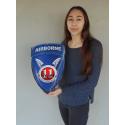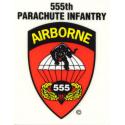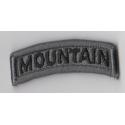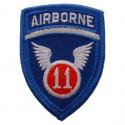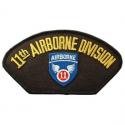11th Airborne Division Challenge Coin
1.53"
The 11th Airborne Division ("Angels") was a United States Army airborne formation, first activated on 25 February 1943, during World War II. Consisting of one parachute and two glider infantry regiments, with supporting troops, the division underwent rigorous training throughout 1943. It played a vital role in the successful Knollwood Maneuver, which was organized to determine the viability of large-scale American airborne formations after their utility had been called into question following a disappointing performance during the Allied invasion of Sicily.
Held in reserve in the United States for the first half of 1944, in June the division was transferred to the Pacific Theater of Operations. Upon arrival it entered a period of intense training and acclimatization, and by November was judged combat-ready. The 11th Airborne saw its first action on the island of Leyte in the Philippines, but in a traditional infantry role. In January 1945 the division took part in the invasion of Luzon. The two glider infantry regiments again operated as conventional infantry, securing a beachhead before fighting their way inland. The parachute infantry regiment was held in reserve for several days before conducting the division's first airborne operation, a combat drop on the Tagaytay Ridge. Reunited, the division participated in the Liberation of Manila, and two companies of divisional paratroopers conducted an audacious raid on the Los Baños internment camp, liberating two thousand civilians. The 11th Airborne's last combat operation of World War II was in the north of Luzon around Aparri, in aid of combined American and Philippine forces who were battling to subdue the remaining Japanese resistance on the island.
On 30 August 1945 the division was sent to southern Japan as part of the occupation force. Four years later it was recalled to the United States, where it became a training formation. One parachute infantry regiment was detached for service in the Korean War, but on 30 June 1958 the division was inactivated. It was briefly reactivated on 1 February 1963 as the 11th Air Assault Division (Test) to explore the theory and practicality of helicopter assault tactics, and was inactivated on 29 June 1965. The division's personnel and equipment were transferred to the newly raised 1st Cavalry Division (Airmobile).


